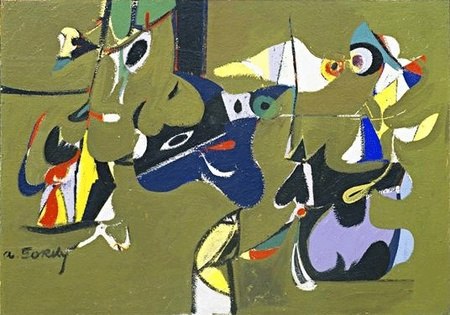
I don't know why I do it either, but here is Washington Post arts blogger Blake Gopnik ruminating on just what it is that makes Arshile Gorky's paintings so upbeat, so appealing:
The most striking thing about this AbEx show is how cheery and bright many of its paintings seem - as cheery as Gorky's "Garden [in Sochi]" - given that the movement is so often associated with gloomy existentialism, post-war angst and the dark Freudian unconscious. Could it be that its true roots are in the post-war boom and a country, and a city, coming into their own as cultural and economic hot spots? (But if so, why is Gorky having fun in paint in 1941 already? Or could it be that painting is an inherently affirmative, cheery act, and that painters can only ever mimic gloom, with the risk that silver linings may show through at any moment, in any work.)Fun in paint? I'd have gone with, "tortured nostalgia for the garden his family had to flee during the Armenian genocide, during an attempt to blot out the horrors of the forced refugee march where his mother died of starvation, but not before instilling in her young son a desperate ambition which became the altar upon which a perennially destitute, lying, insecure Gorky sacrificed his own family and which, after abandonment, cancer and a debilitating car wreck, led him to hang himself from a tree." But if you see "fun in paint," I guess that's...
Anyway, the Garden in Sochi paintings are more properly considered surrealist, transitional, or proto-AbEx, similar to early the figurative/narrative/symbolic work by the other two members of the Fun In Paint School, Pollock and Rothko.
An interview with Gorky's wife Agnes Magruder, conducted on the occasion of Tate Modern's Gorky retrospective. She seems far more interesting than the subject matter lets on. [tate.org.uk]
Related: Gorky was an expert camofleur












